巴西试验也称劈裂试验,沿圆盘试样的直径施加一对载荷,受压直径受拉直至开裂破坏,此方法主要用来间接测量岩石、混凝土、陶瓷和玻璃等脆性材料的拉伸强度[1-3]。对脆性高聚物粘结炸药(PBX),制备直接拉伸试样工艺复杂、所需药量大、周期长,而巴西试验的最大优点就是所需材料少、试样制备简单,可以方便、快捷地制备试样并进行试验。Johnson[4-5]用传统的巴西试验对某PBX炸药的抗拉强度和应变进行了研究,国内也有学者借助巴西试验法研究PBX炸药的力学性能[6-7]。传统巴西试验方法采用平板对样品进行加载,加载区域的应力集中严重影响测试结果,从而导致传统巴西试验得到的拉伸强度与直接拉伸试验强度偏差很大,低约30%~50%。Johnson[5]对15个批次的相同炸药采用等静压法压制炸药件,以直接拉伸试验方法和巴西试验方法分别进行实验,建立了两种结果的相关性,用巴西实验结果反推拉伸强度。然而,Johnson的相关系数法是对密度、压制工艺相同的同种炸药进行分析,得到的相关系数不能推广到其它种类的炸药,因此,相关系数法不能满足科研生产的需要。Hondros[8]和Mellor[9]将平板加载改为圆弧加载,大大提高了测试结果的准确性,Clobes[10]用圆弧加载巴西试验方法研究多孔氧化铝的断裂性能,Jonsén[11]用圆弧加载巴西试验方法研究不同密度的金属粉末压制试样的拉伸强度,这些研究表明圆弧加载巴西试验的适用性。王启智[12-14]等用平台试样替代传统巴西试样,计算出了试样从中心起裂破坏的最小平台圆心角,得到了有效的载荷-位移加载曲线。本研究则对某PBX进行了传统巴西试验和圆弧加载巴西试验,同时还用橡胶垫代替圆弧加载夹具对PBX炸药进行试验(以下称“橡胶垫巴西试验”),对比分析了不同加载方式巴西试验结果之间的差异。
2 试验 2.1 PBX试验种类及设备对某种PBX炸药分别进行了直接拉伸试验、传统巴西试验、圆弧加载巴西试验和橡胶垫巴西试验,试验设备为材料试验机INSTRON5582,试验环境条件为(20±2) ℃。
2.2 直接拉伸试验直接拉伸试样为哑铃状,直径为15 mm,试验结果见表 1。以平均值代表此PBX的拉伸强度,为5.50 MPa。
| 表 1 直接拉伸试验结果 Tab.1 Test results of PBX by tensile test |
传统巴西试验方法如图 1所示,通过平板给圆形样品施加一对径向载荷,当圆心处的拉应力达到材料的拉伸破坏强度时样品受拉破坏,以式(1)计算试样的拉伸强度。
| $ {\sigma _t} = \frac{{2P}}{{{\rm{ \mathsf{ π} }}Dt}} $ | (1) |
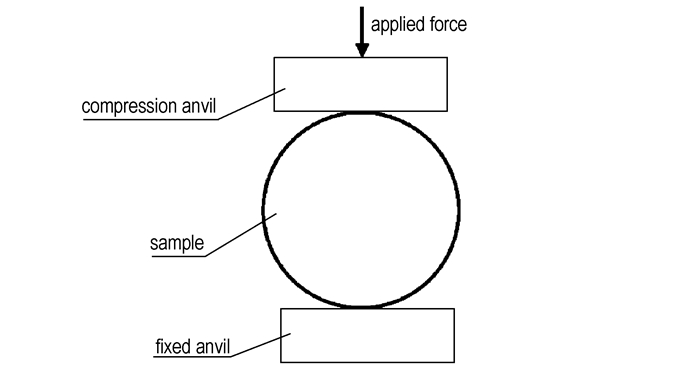
|
图 1 巴西试验示意图 Fig.1 Diagram of the Brazilian test |
式中,P为集中载荷,D为样品直径,t为样品厚度。根据Griffith强度准则,文献[12-13]认为巴西试验最早从中心起裂而破坏,因此传统巴西试验必须满足两个条件:中心起裂和平面应力状态。为了考察样品的应力状态对PBX炸药间接拉伸强度的影响,对不同厚度的样品进行测试,每个厚度为一组,每组5发样品,尺寸及结果见表 2。
| 表 2 传统巴西试验结果 Tab.2 Test results by the traditional Brazilian test |
圆弧巴西试验[6-7]如图 2所示,加载夹具与样品的接触面为弧形,本文中圆弧对应的中心角为30°,以式(1)计算[11]的测试结果见表 3。
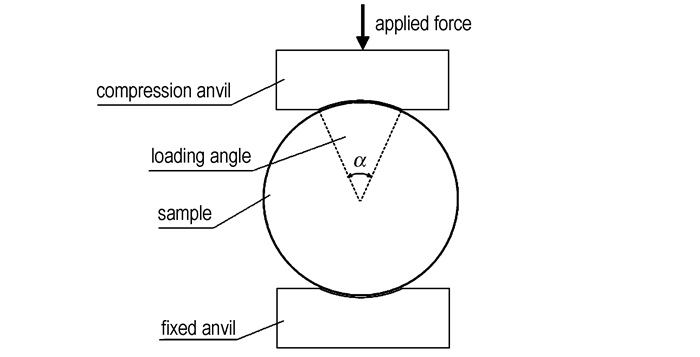
|
图 2 圆弧巴西试验示意图 Fig.2 Diagram of the Arc-Brazilian test |
| 表 3 30°圆弧巴西试验结果 Tab.3 Test results by the Arc-Brazilian test |
橡胶垫巴西试验如图 3所示,在平面加载夹具与样品之间放置一块高弹性橡胶垫,加载后橡胶垫发生变形,与样品之间形成了一定的弧度,如图 3b所示,以式(1)计算的橡胶垫巴西试验结果见表 4。
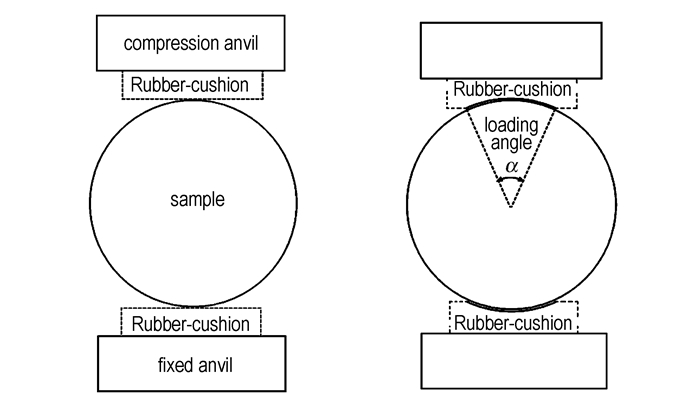
|
图 3 橡胶垫巴西试验示意图 Fig.3 Diagram of the Rubber cushion-Brazilian test |
| 表 4 橡胶垫巴西试验 Tab.4 Test results by the Rubber cushion-Brazilian test |
文献[11-12, 14]指出,有效的巴西试验曲线如图 4a所示,包括三个部分,一是弹性变形,从加载开始到载荷达到最大值Pe; 二是起裂破坏,在最大值Pe时裂纹从试样中心部位引发,并沿加载直径方向稳定扩展,直到载荷达到局部最小载荷Pmin时形成了贯通的主裂纹,样品一分为二; 三是载荷的再缓慢爬升,但不会超过前面的最大值Pe,此阶段属于样品受压。而无效的曲线变化趋势如图 4b所示,达到最大载荷后载荷突然垂直跌落,再也升不起来,此值比有效结果偏低约30%。
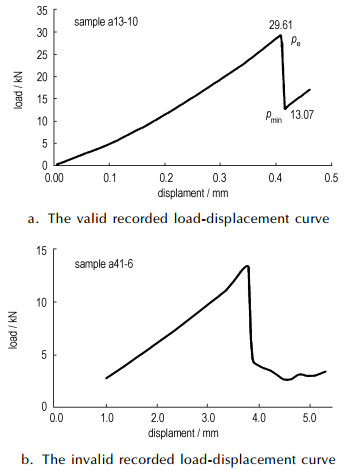
|
图 4 有效和无效载荷-位移曲线对比[14] Fig.4 Comparison of the valid recorded load-displacement curve with the invalid curve |
在本研究中,PBX传统巴西试验、圆弧巴西试验和橡胶垫巴西试验曲线如图 5所示。传统巴西试验加载曲线与无效的巴西试验曲线图 4b相似,载荷达到最小值后再也升不上来,拉伸强度也比直接拉伸强度值5.50 MPa低约35%,表明了传统巴西试验测得的强度严重失真。与传统巴西试验结果相比,30°弧形巴西试验测得的PBX的间接拉伸强度值有较大提高,大部分值与直接拉伸强度相当,表明30°弧形巴西试验比传统巴西试验更准确,但是个别弧形巴西试验的结果比直接拉伸强度低20%左右,主要原因可能在于:(1)由于PBX巴西试验样品通过机械加工而成,样品的直径可能不均匀,导致样品与弧形夹具之间的接触较差;(2)在加载末期,由于样品的变形导致弧形夹具与样品之间还存在一定的应力集中;(3)放置样品时样品的轴线与弧面的轴线不平行。橡胶垫巴西试验得到的平均值为5.48 MPa,标准偏差为0.21 MPa,与直接拉伸强度值的平均值和标准偏差都接近,加载曲线与有效的平台巴西试验加载曲线图 4a相似,说明橡胶垫巴西试验方法能够比较准确、稳定地表征PBX的拉伸强度。
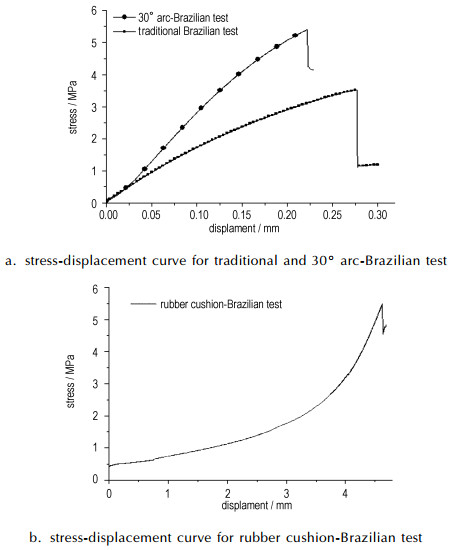
|
图 5 不同形式的巴西试验应力-位移曲线 Fig.5 Stress-displacement curve for different Brazilian test |
PBX传统巴西试验样品破坏后的形貌如图 6所示,由于受应力集中的影响,受压点出现五条次裂纹,其中3、4和5号三条裂纹与主裂纹相连,并且主裂纹未通过样品的中心点;30°圆弧加载的样品破坏图如图 7所示,主裂纹从样品的中心贯通样品的直径,虽然圆弧面对改善应力集中有一定的效果,但是在圆弧的末端与样品的接触点存在应力集中,因此产生两条次裂纹,如图 7b所示;橡胶垫巴西试验后样品破坏如图 8所示,主裂纹不仅从样品的中心贯通样品的直径,并且在受压区域没有次裂纹产生。

|
图 6 传统巴西试验样品破坏图 Fig.6 The failure of sample by traditional Brazilian test |
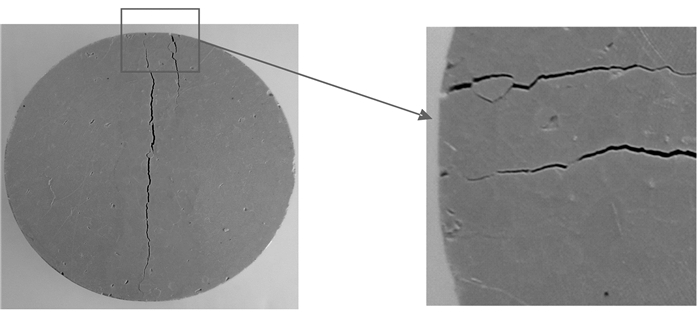
|
图 7 30°圆弧加载破坏样品 Fig.7 The failure of sample by the Arc-Brazilian test |
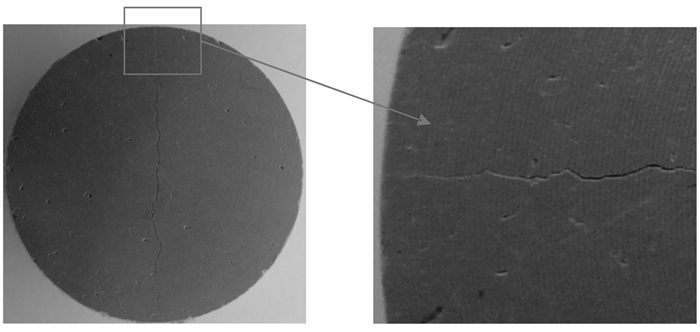
|
图 8 橡胶垫加载破坏样品 Fig.8 The failure of sample by Rubber cushion-Brazilian test |
(1) 传统巴西试验测得的间接拉伸强度比直接拉伸强度低约35%;圆弧巴西试验得到的强度与直接拉伸强度接近,但个别值低于直接拉伸强度;橡胶垫巴西试验结果与直接拉伸强度一致。
(2) 传统巴西试验和30°圆弧加载试验曲线为无效加载曲线,而橡胶垫加载巴西试验曲线为有效加载曲线。
(3) 传统巴西试验方法中样品受集中力的影响很大,加载区域可能早于圆心破坏,导致测得的间接拉伸强度偏低,圆弧加载只能部分改善巴西试样的应力集中,而橡胶垫加载巴西试验测试方法从开始加载到结束持续、有效地改善样品的应力集中。
| [1] |
ISRM(International Society for Rock Mechanics). Suggested methods for determining tensile strength of rock materials[J].
Int J Rock Mech and Min & Geomech Abstr, 1978, 15(1): 99-103. |
| [2] |
GB/T 50266-1999, 工程岩体试验方法标准[S].
GB/T 50266-1999, Standard for tests method of engineering rock masses[S]. |
| [3] |
ASTM C496-2004, Standard Test Method for Splitting Tensile Strength of Cylindrical Concrete Specimens[S].
|
| [4] |
Johnson H D. Mechanical properties of high explosives[R]. MHSMP-74-19: 1974.
|
| [5] |
Johnson H D. Diametric disc and standard tensile-test correlation study[R]. MHSMP-81-22: 1981.
|
| [6] |
宋华杰, 郝莹, 董海山, 等. 用直径圆盘试验评价小样品塑料粘结炸药拉伸性能的初步研究[J].
爆炸与冲击, 2001, 21(1): 35-40. SONG Hua-jie, HAO Ying, DONG Hai-shan, et al. A preliminary evaluation of tensile properties of small plastic bonded explosive sample by diametric disc test[J]. Explosion and Shock Waves, 2001, 21(1): 35-40. |
| [7] |
陈鹏万, 黄风雷, 张瑜, 等. 用巴西实验评价炸药的力学性能[J].
兵工学报, 2001, 22(4): 533-537. CHEN Peng-wan, HUANG feng-lei, ZHENG Yu, et al. Brazilian test and its application in the study of the mechanical properties of explosives[J]. Acta Armamentarii, 2001, 22(4): 533-537. |
| [8] |
Hondros G. The valuation of Poisson's ratio and the modulus of materials of a low tensile resistance by the Brazilian (indirect tensile) test with particular reference to concrete[J].
Aust J Appl Sci, 1959, 10: 243-268. |
| [9] |
Mellor M, Hawlers I. Measurement of tensile strength by diametrical compression of discs and annuli[J].
Eng Geol, 1971, 5: 173-225. DOI:10.1016/0013-7952(71)90001-9 |
| [10] |
Clobes J K, Green D G. Validation of single-edge V-notch diametral compression fracture toughness test for porous alumina[J].
Journal of Materials Science, 2002, 37: 2427-2434. DOI:10.1023/A:1015414917833 |
| [11] |
Jonsé P, Häggblad H.-Å, Sommer K. Tensile strength and fracture energy of pressed metal powder by diametral compression test[J].
Powder technology, 2007, 176: 148-155. DOI:10.1016/j.powtec.2007.02.030 |
| [12] |
Wang Q Z, Xing L. Determination of fracture toughness KIc by using the flattened Brazilian disk specimen for rocks[J].
Eng Fract Mech, 1999, 64(2): 193-201. DOI:10.1016/S0013-7944(99)00065-X |
| [13] |
王启智, 贾学明. 用平台巴西圆盘试样确定脆性岩石的弹性模量、拉伸强度和断裂韧度——第一部分:解析和数值结果[J].
岩石力学与工程学报, 2002, 21(9): 1285-1289. WANG Qi-zhi, JIA Xue-ming. Determination of elastic modulus, tensile strength and fracture toughness of brittle rocks by using flattened Brazilian disk specimen-part Ⅰ: analytical and numerical results[J]. Chinese Journal of Rock Mechanics and Engineering, 2002, 21(9): 1285-1289. |
| [14] |
王启智, 吴礼舟. 用平台巴西圆盘试样确定脆性岩石的弹性模量、拉伸强度和断裂韧度——第二部分:试验结果[J].
岩石力学与工程学报, 2004, 23(2): 199-204. WANG Qi-zhi, WU Li-zhou. Determination of elastic modulus, tensile strength and fracture toughness of brittle rocks by using flattened Brazilian disk specimen-part Ⅱ: experimental results[J]. Chinese Journal of Rock Mechanics and Engineering, 2004, 23(2): 199-204. |
| [15] |
尤庆明, 苏承东. 平台圆盘劈裂的理论和试验[J].
岩石力学与工程学报, 2003, 23(9): 170-174. YOU Qing-ming, SU cheng-dong. Split test of flattend rock disk and related theory[J]. Chinese Journal of Rock Mechanics and Engineering, 2003, 23(9): 170-174. |

The stress-displacement curve for Rubber cushion-Brazilian test is valid recorded load-displacement curve and the failure of sample by Rubber cushion-Brazilian test is failure initially at the center of sample.



